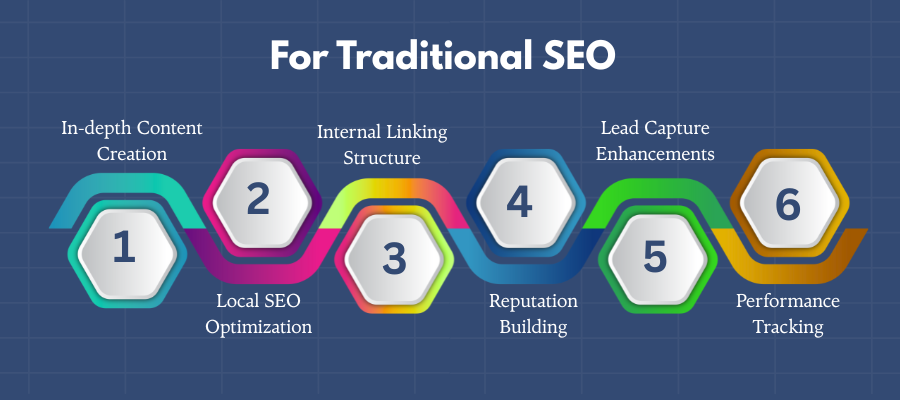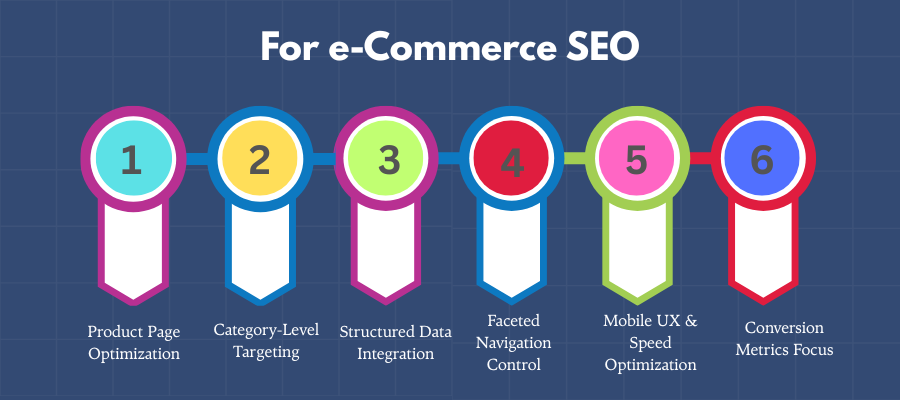Ecommerce SEO vs. Traditional SEO: What’s the Difference?
Summary: Traditional SEO and e-commerce SEO may share a common goal of visibility, but their strategies, structure, and success metrics are worlds apart. Knowing which one aligns with your business model can make the difference between steady growth and stagnant results. Whether you’re offering services or selling products online, understanding their core differences helps create a smarter, more results-driven digital marketing approach.
Key Takeaways
- Identify whether your business needs traditional SEO, e-commerce SEO, or both.
- Align your SEO strategy with your industry and customer journey.
- Choose keywords based on intent informational vs. transactional to attract the right traffic.
- Structure your website to support your SEO goals and user behavior.
- Make smarter SEO decisions with a strategy tailored to your business model.
Selling services? Selling products? Your SEO game can’t look the same.
One of the biggest mistakes businesses make is treating e-commerce SEO and traditional SEO as interchangeable. The result? Low traffic, poor rankings, and confused customers who bounce before they buy. Each SEO approach has its own rules, structure, and audience behavior and mixing them up can silently drain your marketing budget.
Let’s break down the real differences between the two, so you can stop guessing and start ranking where it matters. Whether you’re a service provider or an online seller, the right SEO strategy will help you attract the right audience and convert them faster.
Table of Contents
Toggle- What is Traditional SEO?
- What is e-Commerce SEO?
- E-commerce SEO vs. Traditional SEO: What's the Difference?
- SEO Strategy Development: How They Differ
- Key Metrics to Measure Success
- Common Mistakes to Avoid in Both
- Signs Your Business Needs Traditional SEO
- Signs Your Business Needs e-Commerce SEO
- When to Choose Ecommerce SEO vs. Traditional SEO
- Why Choose Agha DigiTech for Your SEO Needs?
- Final Thoughts
- Frequently Asked Questions (FAQ's)
What is Traditional SEO?

Traditional SEO focuses on optimizing websites that offer information, services, or lead-generation content rather than selling physical products online. It revolves around creating high-quality content, improving site structure, building backlinks, and ranking for relevant keywords to attract organic traffic. The goal is to generate inquiries, phone calls, or form submissions from users seeking specific services or solutions.
Industries Best Suited for Traditional SEO:
Industries that rely on customer trust, in-depth service explanations, and long-term engagement benefit most from traditional SEO. These businesses often depend on ranking informative pages, case studies, and local searches to drive inquiries.
- Legal Services (e.g., law firms)
- Healthcare Providers (e.g., clinics, hospitals)
- Real Estate Agencies
- Financial Services (e.g., insurance, accounting)
- Education & eLearning Platforms
- Business Consulting Services
- Hospitality (e.g., hotels, travel agencies)
- Home Improvement & Repair Services
- IT & Software Services
- Marketing & Advertising Agencies
What is e-Commerce SEO?

E-commerce SEO is the process of optimizing online stores to help product and category pages rank higher in search engine results. It focuses on technical optimization, rich product descriptions, seamless navigation, and user-focused strategies. SEO for eCommerce industry specifically aims to drive qualified traffic, improve the shopping experience, reduce cart abandonment, and ultimately boost conversions through stronger organic visibility.
Industries Best Suited for e-Commerce SEO:
Industries with large inventories, product variations, and competitive pricing models thrive through e-commerce SEO. Success here often depends on optimizing product feeds, schema markup, and mobile UX to enhance search presence and conversions.
- Fashion & Apparel
- Electronics & Gadgets
- Health & Wellness Products
- Home Decor & Furniture
- Beauty & Personal Care
- Grocery & Food Delivery
- Baby Products & Toys
- Sports & Fitness Equipment
- Jewelry & Accessories
- Pet Supplies
E-commerce SEO vs. Traditional SEO: What's the Difference?
When choosing the right SEO strategy, understanding the clear differences between e-commerce and traditional SEO is crucial. As a leading SEO service provider company, we often see businesses applying the wrong tactics costing them traffic and sales. Here’s a side-by-side comparison to help you pick the approach that aligns with your business model and goals.
Feature / Element | Traditional SEO | E-commerce SEO |
Primary Objective | Drive traffic to generate leads, inquiries, or service bookings through informative content and service-focused pages. | Increase organic product visibility to drive online sales, reduce bounce rates, and improve checkout conversions. |
Website Structure | Typically includes homepage, service pages, about us, blog, and contact forms. Navigation is simple and geared toward education or consultation. | Complex structure with layered product categories, individual product pages, filters, and dynamic URLs. Requires organized taxonomy and crawl-friendly navigation. |
Keyword Strategy | Focuses on informational and service-related keywords (e.g., “best digital marketing agency in Jaipur”) with local SEO targeting. | Targets transactional and long-tail keywords (e.g., “buy red running shoes online”) that indicate high purchase intent. Often includes brand and product-specific terms. |
Content Approach | Long-form blogs, how-to guides, case studies, service descriptions, and thought leadership content to establish authority. | Product descriptions, comparison pages, FAQs, product reviews, user-generated content, and rich snippets optimized for quick buyer decisions. |
On-Page SEO Focus | Optimizing service-related keywords, metadata, image alt text, header tags, internal linking, and local SEO elements like NAP. | Prioritizes unique product titles, schema markup, image SEO, keyword-rich descriptions, filter crawlability, and structured data for products and reviews. |
Conversion Goals | Drive calls, email sign-ups, contact form submissions, or bookings for services. | Drive actions like “Add to Cart”, “Buy Now”, and product purchases. Conversion funnels are tied to real-time product interest. |
Technical SEO Complexity | Moderate. Focuses on mobile-friendliness, fast load times, internal linking, SSL, schema for services, and sitemaps. | High. Involves dynamic URL handling, pagination issues, canonical tags, XML sitemaps for product feeds, mobile UX, structured data for rich results, and inventory changes. |
Local SEO Role | Crucial. Local pack rankings and Google Business Profile optimization are key for businesses targeting regional customers. | Limited. Only important if the e-commerce business also has physical stores or offers location-based shipping options. |
UX / UI Focus | Clean navigation, CTA placement, readable content, and fast-loading service pages. | Streamlined purchase journey, product filters, quick add-to-cart, seamless checkout experience, mobile optimization, and cross-selling/upselling features. |
Content Refresh Frequency | Moderate. Blogs and service pages are updated occasionally based on trends, news, or performance. | High. Frequent product updates, inventory changes, seasonal campaigns, and promotions require constant SEO monitoring and optimization. |
Analytics & Tracking Metrics | Focuses on metrics like leads generated, bounce rate, CTR, keyword rankings, and page engagement. | Focuses on cart abandonment rate, product views, conversion rate, average order value, and revenue from organic search. |
Common Tools Used | Google Analytics, Google Search Console, SEMrush, Ahrefs, Screaming Frog, Yoast SEO. | Google Merchant Center, Structured Data Testing Tool, Rank Math (for WooCommerce), Shopify SEO tools, product feed management platforms. |
User Intent Focus | Primarily informational or navigational users are researching before committing to a service. | Primarily transactional users are ready to buy or comparing similar products based on features, reviews, and price. |
Content Management Platforms | Often built on WordPress, Joomla, Drupal, or custom CMS platforms suited for content-heavy websites. | Typically built on e-commerce platforms like Shopify, WooCommerce, Magento, BigCommerce, or Wix eCommerce with integrated SEO plugins and product management. |
This detailed breakdown makes it clear that while both traditional and e-commerce SEO share a foundational purpose enhancing visibility and driving action the execution, content types, and technical approach must align with the unique journey of your target audience.
SEO Strategy Development: How They Differ
A one-size-fits-all approach to SEO rarely works especially when the end goals differ. Traditional SEO strategies focus on building authority and generating service inquiries, while e-commerce SEO is conversion-driven and product-centric. Understanding how strategies differ between these two helps ensure your SEO efforts align with your customer journey and business model.
For Traditional SEO

The strategy revolves around content depth, local signals, and trust-building to convert visitors into leads. It’s ideal for businesses offering professional services, consultations, or expertise.
- In-depth Content Creation: Focus on creating long-form blogs, case studies, and service pages that educate users, address pain points, and establish your brand as an industry expert.
- Local SEO Optimization: Optimize for location-specific keywords, add local schema, and maintain an updated Google Business Profile to rank in map packs and drive regional traffic.
- Internal Linking Structure: Use strategic internal linking between blogs and core service pages to boost authority, help crawlers, and guide users through your service offerings.
- Reputation Building: Earn quality backlinks from industry directories, forums, guest posts, and authoritative publications to strengthen your domain’s trustworthiness and authority.
- Lead Capture Enhancements: Design SEO landing pages with compelling CTAs, contact forms, and trust signals like testimonials or certifications to improve conversion rates.
- Performance Tracking: Measure success using tools like Google Analytics and Search Console, focusing on lead submissions, bounce rate, keyword rankings, and organic traffic growth.
For e-Commerce SEO

E-commerce SEO strategies prioritize scalability, structured data, and user experience to support large product catalogs and drive direct purchases.
- Product Page Optimization: Write unique, keyword-rich product titles and descriptions to avoid duplication, while also ensuring meta tags are optimized for clicks and conversions.
- Category-Level Targeting: Optimize category pages with high-volume commercial keywords, filters, and content blocks that help users find products and improve internal link equity.
- Structured Data Integration: Use product schema, review schema, and availability markup to help search engines show rich results like ratings, price, and stock directly in SERPs.
- Faceted Navigation Control: Implement canonical tags, noindex rules, and proper parameter handling to prevent duplicate content caused by filters and dynamic sorting.
- Mobile UX & Speed Optimization: Prioritize fast-loading, mobile-friendly design with intuitive navigation, quick view options, and a frictionless checkout process to reduce bounce and increase conversions.
- Conversion Metrics Focus: Track and analyze product views, add-to-cart actions, checkout completions, cart abandonment rates, and overall organic revenue to measure true ROI.
Key Metrics to Measure Success
Tracking performance is key to refining your SEO strategy whether it’s traditional or e-commerce. While goals differ, both rely on data-backed decisions to improve visibility and ROI. Using the top SEO tools, businesses can monitor essential KPIs that indicate what’s working and where improvement is needed. Below is a detailed comparison of metrics you should track based on your SEO approach.
Metric | Traditional SEO | E-commerce SEO | Top SEO Tools to Use |
Organic Traffic | Measures total visitors from search engines to service, blog, and contact pages. | Tracks visits to product and category pages from organic sources. | Google Analytics, SEMrush, Ahrefs |
Keyword Rankings | Tracks how well service-related or local keywords are ranking in SERPs. | Monitors rankings of product-specific and transactional keywords across different locations. | Ahrefs, SEMrush, Moz, Google Search Console |
Bounce Rate | Indicates how many users leave after visiting a page without taking any action. | Helps analyze if product pages or listings meet buyer expectations and encourage interaction. | Google Analytics, Hotjar |
Conversion Rate | Tracks form submissions, bookings, or contact requests from service pages. | Measures how many users complete a purchase after visiting product or checkout pages. | Google Analytics, Mixpanel, HubSpot |
Click-Through Rate (CTR) | Shows how often people click on your service listings in search results. | Indicates effectiveness of product titles, meta descriptions, and rich snippets in driving clicks. | Google Search Console, Rank Math, Yoast SEO |
Backlink Profile | Tracks number and quality of inbound links to improve domain authority and credibility. | Measures product-related mentions, reviews, and links to category or product pages. | Ahrefs, Moz, SEMrush |
Page Load Speed | Critical for retaining users on blogs or service pages especially on mobile. | Directly impacts product browsing experience, cart abandonment, and SEO rankings. | Google PageSpeed Insights, GTMetrix, Lighthouse |
User Behavior Flow | Visualizes how visitors navigate between blog posts, service pages, and CTAs. | Tracks how users move across product pages, filters, and checkout funnels. | Google Analytics, Hotjar, Crazy Egg |
Cart Abandonment Rate | Not applicable. | Measures the percentage of users who add items to cart but leave before completing the purchase. | Shopify Analytics, Google Analytics, Klaviyo |
Revenue from Organic Search | Evaluated indirectly via leads that turn into clients through service consultations. | Directly measured based on completed purchases attributed to organic search. | Google Analytics (Enhanced eCommerce), Shopify, WooCommerce Reports |
Tracking these tailored metrics with the top SEO tools allows you to make smarter decisions, improve rankings, boost engagement, and ultimately grow your business whether you’re selling services or products.
Common Mistakes to Avoid in Both
Whether you’re focusing on traditional SEO or e-commerce SEO, several missteps can limit your success. Many businesses unknowingly apply the wrong tactics or over-rely on automation tools like AI Content Writing Tools, which can compromise quality and relevance. Avoiding the following mistakes can help improve your SEO strategy and drive better results across search engines.
- Ignoring Search Intent: Crafting content without truly understanding what users are searching for leads to poor engagement and irrelevant traffic even if the page ranks on SERPs initially.
- Overusing AI Content Writing Tools: Relying heavily on AI to generate content without human review often produces generic, keyword-stuffed text that fails to match your brand voice or user expectations.
- Duplicate Meta Tags: Applying the same meta titles or descriptions across multiple pages confuses search engines and hurts your ability to rank product or service pages individually.
- Thin Content on Key Pages: Pages with minimal or repetitive content often auto-generated by AI tools offer little value to users and reduce chances of ranking competitively on Google.
- Slow Website Speed: Unoptimized images, bulky scripts, and poor hosting contribute to high bounce rates and negatively impact your organic visibility, especially on mobile devices.
- Poor Internal Linking: Skipping logical internal links between content silos weakens keyword authority and makes it difficult for both users and crawlers to navigate your site efficiently.
- Not Using Schema Markup: Without structured data, your content misses the chance to appear as featured snippets, rich results, or product ratings in search results costing you visibility.
- Inconsistent Content Updates: Publishing content using AI Content Writing Tools and forgetting to refresh it periodically can make your site appear outdated and lower its trustworthiness.
- Ignoring Mobile Optimization: With mobile-first indexing, having a non-responsive layout or poor mobile UX can significantly lower your site rankings and user satisfaction rates.
- Skipping Analytics Reviews: Failing to consistently review SEO reports and key metrics leads to missed optimization opportunities, poor content performance, and limited insight into user behavior.
Signs Your Business Needs Traditional SEO
If your business focuses more on generating leads, educating customers, or offering services rather than selling products online, traditional SEO is likely your ideal growth channel. Many service-based companies struggle with visibility simply because they use strategies designed for product pages. Here’s a detailed table to help you identify clear signs that your business should adopt a traditional SEO approach:
Sign | What It Means | Why Traditional SEO Is Ideal |
You offer services, not products | Your business revolves around consultations, appointments, or client-based solutions. | Traditional SEO helps rank service pages, drive leads, and build authority through informational content. |
You rely heavily on local customers | Your clients are primarily within a geographic area (e.g., city, state, region). | Traditional SEO emphasizes local SEO tactics like Google Business Profile optimization and local keyword targeting. |
Your website lacks a shopping cart | There’s no transactional element just contact forms, phone numbers, or inquiry buttons. | SEO efforts are focused on boosting visibility of landing pages that convert visitors into leads, not buyers. |
Content is your primary driver of traffic | Blogs, guides, and case studies are your top-performing pages. | Traditional SEO supports long-form content strategies that build trust, answer queries, and establish expertise. |
Your sales cycle is longer | Users take time to decide, comparing options or consulting before choosing. | Traditional SEO nurtures prospects through informative and engaging content that supports decision-making. |
You depend on calls, form fills, or bookings | Your conversions come from actions like scheduling demos, consultations, or inquiries. | SEO is tailored to optimize for these conversion types rather than direct purchases. |
Your competition is service-based | Competing businesses rank with service pages or informational content not product listings. | Traditional SEO helps you stay competitive by following industry-standard optimization strategies for service niches. |
Your business has seasonal or campaign-based promotions | You run service offers during specific times of the year or on a campaign basis. | SEO can be tailored to support short-term visibility through timely blog posts and optimized landing pages. |
Signs Your Business Needs e-Commerce SEO
If your business revolves around selling products online, managing inventories, and handling high-volume traffic, e-commerce SEO is essential. Many brands struggle with visibility and conversions because they apply generic SEO tactics instead of specialized product-driven strategies. Here’s a detailed table to help you identify whether e-commerce SEO is the right fit for your online store or product-based business.
Sign | What It Means | Why e-Commerce SEO Is Ideal |
You sell products online | Your website includes a product catalog, cart, and checkout functionality. | E-commerce SEO focuses on optimizing product and category pages to drive traffic and boost sales. |
You have hundreds or thousands of SKUs | Your business handles large inventories with variations in size, color, brand, etc. | E-commerce SEO helps manage product indexing, avoid duplication, and enhance crawlability across your catalog. |
You run seasonal or flash sales | Your site often features promotions, discounts, or time-sensitive product campaigns. | SEO can be tailored for seasonal keywords and structured data to boost visibility during sale periods. |
Product pages are your top traffic drivers | Most of your visitors land on product or category pages rather than blog or service pages. | E-commerce SEO ensures these pages are fully optimized for search intent and purchase readiness. |
You use structured data for products | Your products appear with star ratings, price, and stock info in search results. | Structured data is a key element of e-commerce SEO, enhancing click-through rates and rich result eligibility. |
You offer shipping across regions or globally | Your audience is not limited by geography products are shipped across cities, states, or countries. | E-commerce SEO focuses on broader keyword targeting and ensures your product pages rank in multiple regions. |
You rely on reviews and user-generated content | Customer reviews and Q&As play a role in influencing purchase decisions. | E-commerce SEO leverages this content to improve trust signals and support long-tail keyword targeting. |
You want to reduce ad spend | Paid campaigns are becoming expensive and unsustainable in the long run. | Strong e-commerce SEO builds organic traffic that lowers dependence on ads and improves profit margins. |
When to Choose Ecommerce SEO vs. Traditional SEO
Choosing between e-commerce SEO and traditional SEO depends on your business model, website structure, and ultimate goals. If your primary objective is to generate leads, offer services, or build long-term client relationships, traditional SEO is your best bet. It’s designed to boost visibility for service pages, blog content, and contact forms ideal for consultants, healthcare providers, lawyers, agencies, and B2B service firms. Traditional SEO focuses on local optimization, in-depth content, and user trust to drive conversions through form submissions, bookings, or inquiries.
On the other hand, if your website’s core purpose is to sell products online, manage inventories, and process payments, then e-commerce SEO is the right choice. It’s tailored to optimize product and category pages, integrate structured data, and handle large-scale content with dynamic URLs. E-commerce SEO works well for businesses in retail, electronics, fashion, beauty, and home goods that rely on high product turnover and transactional intent.
In some cases, businesses may benefit from a hybrid SEO strategy. For example, a fitness brand may sell gym equipment (requiring e-commerce SEO) while also offering personal training services or fitness plans (requiring traditional SEO). In such scenarios, combining both approaches ensures maximum visibility and conversion potential across product and service offerings.
Choosing the wrong strategy or ignoring the need for both can lead to missed opportunities, low ROI, and ineffective search presence. Align your SEO strategy with your customer journey for optimal results.
Why Choose Agha DigiTech for Your SEO Needs?
Every business has a unique digital footprint what works for a service-based company may completely fail for an online retailer. The real challenge isn’t doing SEO, but doing it right for your business model. Many websites suffer from low traffic or poor conversions simply because their SEO strategy doesn’t align with how their users search or behave online.
Agha DigiTech bridges this gap with tailored SEO solutions designed for real-world results. Whether you need in-depth content strategies for service pages or technical optimization for complex product catalogs, our team uses a mix of experience, AI-driven tools, and advanced analytics to build performance-focused strategies. We don’t just chase rankings we help you connect with the right audience, at the right time, in the right way. With Agha DigiTech, your SEO finally works with your business not against it.
Final Thoughts
Understanding the difference between traditional SEO and e-commerce SEO is crucial to crafting a strategy that drives real business outcomes. While both aim to boost visibility, their focus, structure, and execution vary significantly based on whether you offer services or products. Choosing the wrong approach can lead to wasted time, poor rankings, and missed opportunities.
If you’re unsure which SEO path is right for your business, our experts at Agha DigiTech are here to help. We’ll analyze your goals, industry, and audience to build a tailored SEO plan that delivers measurable results.
Ready to grow smarter? Contact us today for a free consultation.
Frequently Asked Questions (FAQ's)
Do both types of SEO use the same keyword research strategy?
While both approaches rely on keyword research, the intent differs. Traditional SEO targets informational, branded, or local service keywords aimed at educating users and generating leads. E-commerce SEO, on the other hand, emphasizes transactional and long-tail keywords like “buy wireless headphones online” to capture high-intent shoppers ready to purchase directly from search.
How does site architecture differ between the two?
E-commerce websites are typically complex, with multi-level product categories, filters, and dynamically generated URLs requiring strategic structuring for crawlability and indexing. In contrast, traditional SEO sites use a cleaner, more linear structure focused on service pages, blogs, and static URLs, which allows easier content navigation for both users and search engines.
Can e-commerce sites rank for informational content too?
Absolutely. E-commerce brands can drive top-funnel traffic by creating informative content like how-to guides, product comparisons, and FAQs. However, to succeed, this content must be housed in a well-structured blog section and follow traditional SEO best practices like internal linking, schema markup, and targeting non-commercial, educational search queries.
What’s a common challenge for e-commerce SEO?
One major challenge is managing duplicate and thin content across thousands of product pages. Dynamic URLs created by faceted navigation or filters can lead to index bloat. To counter this, e-commerce SEO must implement canonical tags, noindex rules, and structured sitemaps to ensure clean crawl paths and optimized indexing.
Is traditional SEO obsolete with AI chatbots emerging?
Not at all. While AI chatbots and answer engines are changing how users find information, traditional SEO is still essential for visibility across organic search and local listings. Businesses must adapt to evolving formats like featured snippets and voice search but should continue building authority through content, backlinks, and technical SEO.




